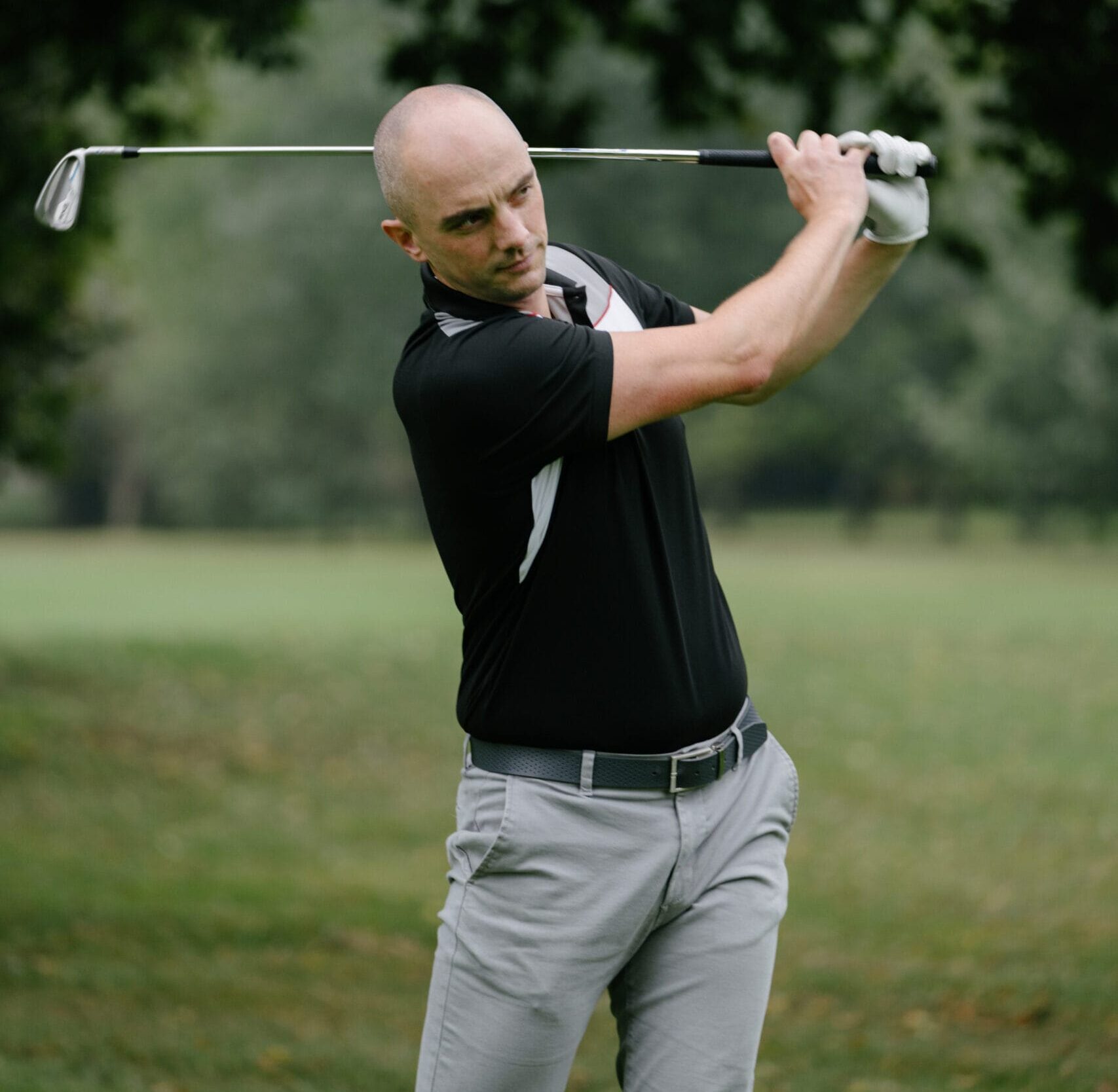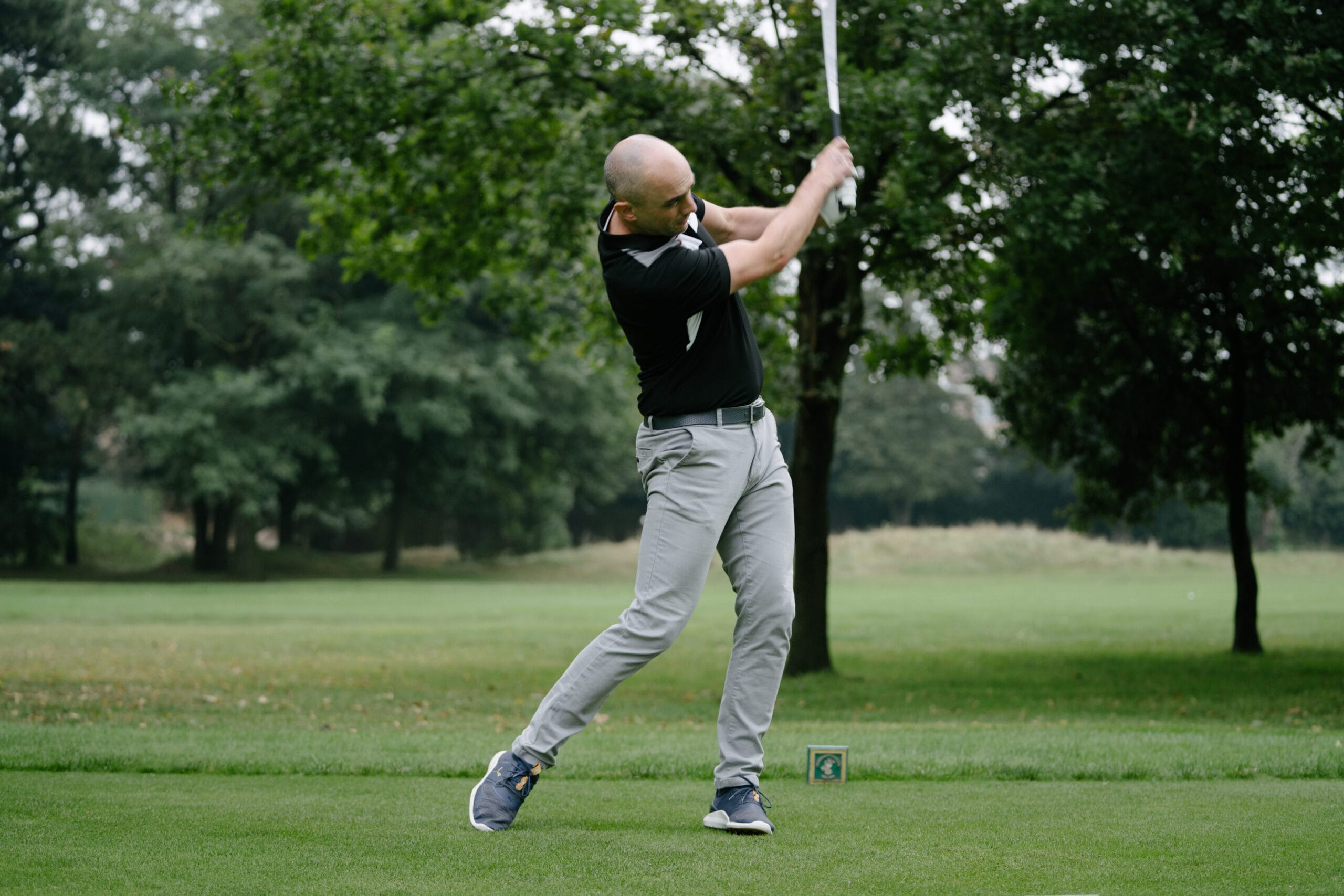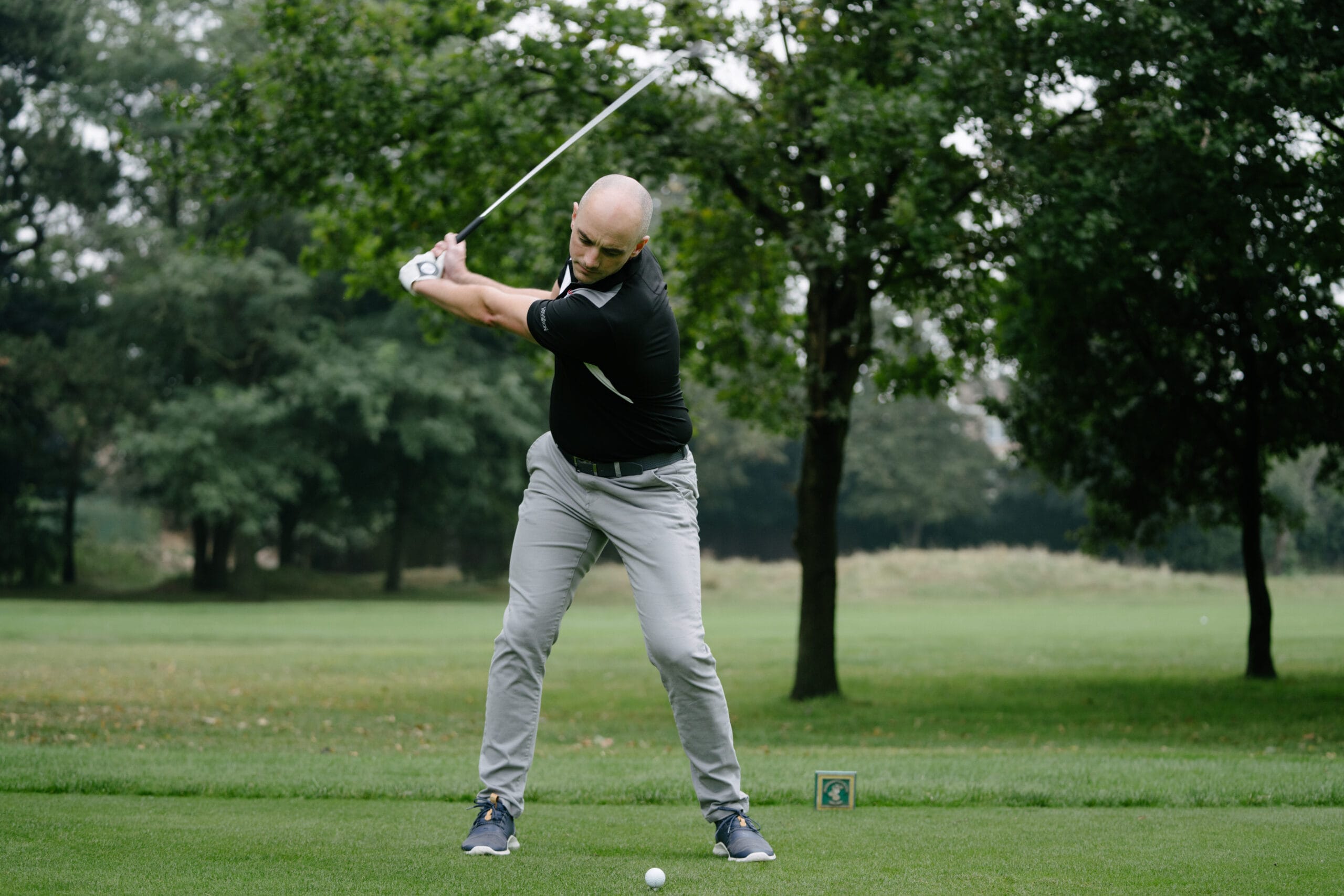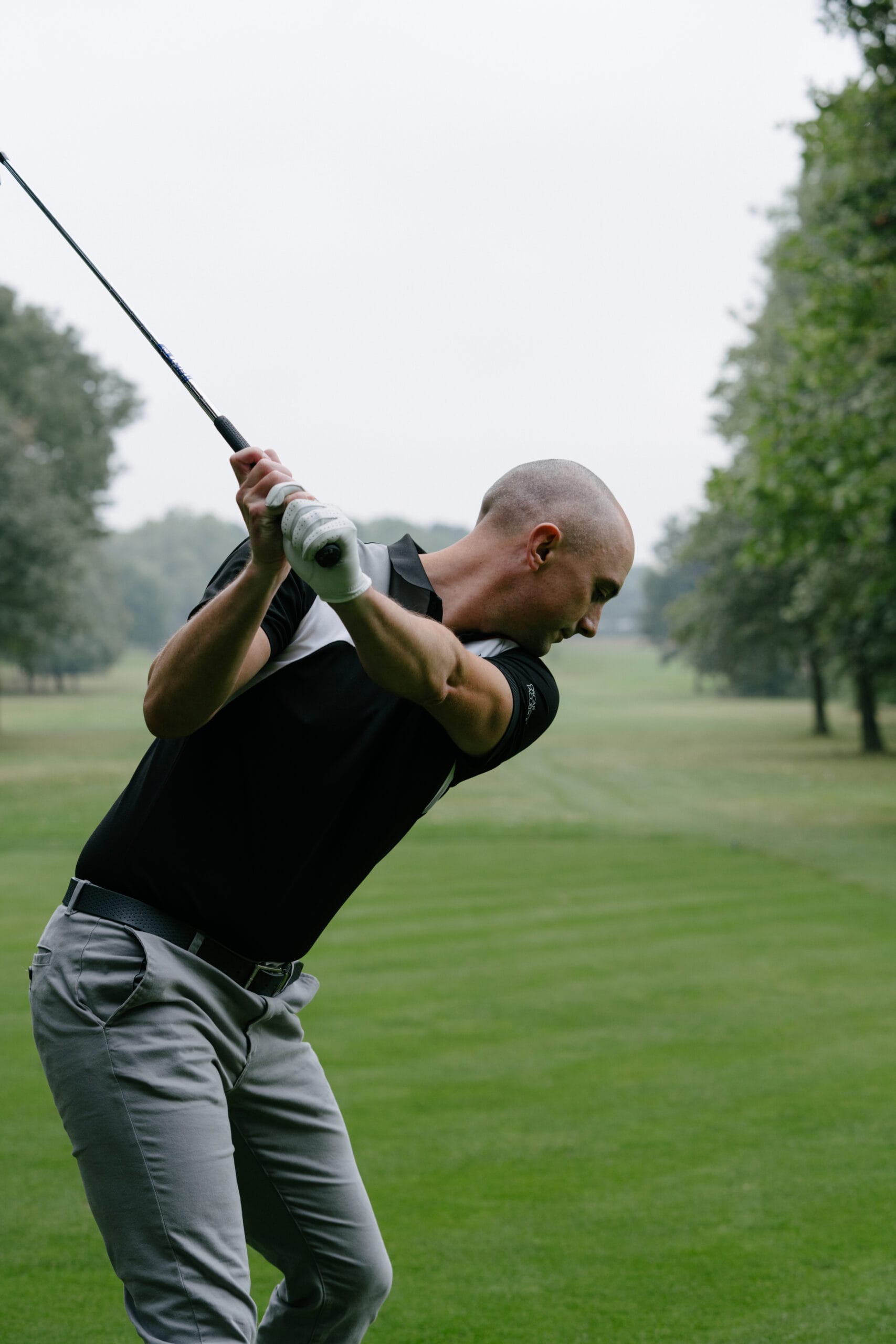The Modern Golfer: Injury Prevention

Pure Sports Medicine
- 4 June, 2019
- Golf
- 4 min read
The Modern Golfer Series: Injury Prevention
The golf swing is a multi-segmented and complex skill which involves accurate body perception and well-coordinated muscular actions (1). It involves a kinetic chain initiated from movement of the legs and hips followed by the trunk and shoulders, and finally the hands and wrists (2). The idea is to create explosive power through a wide range of motion and transfer this power to a ball via a club to propel the ball a great distance with accuracy (3). Typically, a player will maximally recruit 30 lbs of muscle to generate 4 horsepower during the golf swing, which equates to 900kg of force being applied to the ball in half a millisecond at impact (3). This is then repeated multiple times in a round of golf.
Unsurprisingly, golf can generate injuries with expected rates in amateur golfers of between 15.8-40.9% annually and 31-90% annually in professionals (4). As a result, there is a greater emphasis now on developing adequate strength, power, and flexibility training amongst all levels of golfing ability. This is not only to optimise swing mechanics and golf performance but also to prevent injury.
The biomechanics of the golf swing
The swing itself is a highly coordinated, rotational, closed chain activity, requiring strength, explosive power, flexibility and balance (5). It can be divided into the following stages:

From left to right, top row: Image 1 setup/address. Images 2 — 3 backswing. Image 4 transition. Image 5 — 6 (bottom row left) downswing. Image 7 impact. Images 8 — 10 follow through.
Photos courtesy of Riveiro M et al. (2015)
The golf swing can be described as a powerful stretch-shorten cycle (SSC) activity in which the muscles of the lower, mid-section, and upper body are rapidly stretched in the backswing prior to shortening in the downswing (2). The more efficient the SSC, the more club-head velocity can be achieved and, therefore, the greater the distance of the ball.
Power is generated at the transition stage, where the transferring of weight is from the back foot in the backswing onto the front foot during the downswing. The lower body and pelvis initiate the downswing while the upper body and club continue to rotate away from the ball (6). This exaggerates the SSC, creating maximal acceleration on the downswing from the transition stage.
The transfer of weight creates considerable ground reaction force (GRF) where the legs should be pushed into the ground in order to maximise club-head velocity (2). The purpose of the follow-through is to decelerate the body and club head after impact.
Typical golfing injuries and their risk factors
In amateur golfers, the spine, particularly the lower back, accounts for the greatest overall incidence of injury (18.3-36.4%) (4). The elbow (8-33%), the wrist and hand (10-32%), and the shoulder (4-18.6%) are the other most frequent sites in amateur golfers (4). In professional golfers, spinal symptoms are more prevalent (22-41%), as well as wrist and hand injuries (9-38%) (9). Injuries to the lead side (left side for right-handed golfers) are 5 times more frequent than the trail side (84.5%) (9&10).
The main risk factors associated with injury in golfers have been reported as age, gender, a lower handicap, playing/practicing time (overload or underload), suboptimal swing mechanics, and poor preparatory behaviours(lack of a warm-up or fitness) (1,6,7,8,9, 10, 11).
Most injuries occur during the final downswing phase when the club head hits the ball/ ground (17.8%), and in the follow-through (41.6%) (1).
The role of a warm-up
35.2% of golfers never warm-up prior to golf play (11). 62.5% of golfers never warm-up prior to golf practice (11). A warm-up can have the following effects on performance (5&12):
- Faster contraction and relaxation of agonist and antagonist muscles
- Improved rate of force development and reaction time
- Improved muscle strength and power
- Lowered viscous resistance in muscles
- Facilitating oxygen release from haemoglobin and myoglobin
- Increased blood flow to active muscles
- Enhanced metabolic reactions
- Facilitating nerve transmission and motor unit recruitment
The RAMP approach can guide an effective warm-up. It has shown performance enhancement in the short, medium and long-term as well (13).
Raise
body temperature, heart rate, respiration rate, blood flow and joint fluid viscosity.
Activate
key muscle groups
Mobilise
key joints and range of motion specific to the sport
Potentiate
high-intensity dynamic exercises to mimic performance
Below is a quick and easy RAMP warm-up routine. All movements should be dynamic as this movement type has greater performance benefits than static stretching (5,12,13):
Plank into pigeon
Anti-flexion trunk exercise with external rotation of the hips whilst using upper and lower body stabilisation. Hold each leg for a second, then change. Continue for 2 minutes.


Down-dog push up
Another anti-flexion trunk exercise with upper body activation. Additional mobility for scapular, thoracic/ lumbar spine and posterior chain as well as posterior neural mobilisation. Continue for 2 minutes.


Backward lunge with trunk anti-rotation (cable/ elastic resistance)
A posterior chain and sling exercise with oblique activation. Continue for 1 minute on each side.

Pallof press and banded crab walk (cable/ elastic resistance)
Another anti-rotation exercise with hip abduction activation. Continue for 2 minutes on each side.

Spider lunge with thoracic and hip rotation
Great for thoracic rotation and hip internal rotation with lower limb stabilisation. Continue for 2 minutes on each side.

Potentiation should be golf specific. It may look like this on the driving range (5):
- 3-5 full swings shots with sand/ pitching wedge
- 3-5 full swings with 8-iron
- 3-5 full swings with 5-iron
- 3-5 full swings with fairway wood
- 3-5 full swings with driver
- Short-game for touch/feel
References
- 1. Cabri et al. (2009). Eur J Sports Sci. 9(6): 353-366
- 2. Hume et al. (2005). Sports Med. 35(5): 429-449
- 3. Wells et al. (2009). J Strength and Conditioning Research. 23(3): 741-750
- 4. Murray et al. (2016). Br J Sports Med. 0: 1-11
- 5. Tilley, N.R. & Macfarlane, A. (2012). Int J Sports Phys Ther. 7(4): 388-395
- 6. Meira, E.P. & Brumitt, J. (2010). Sports Phys Ther. 2(4): 337-344
- 7. Gluck, G.S. et al. (2008). The Spine J. 8: 778-788
- 8. Robinson, P. G. et al. (2018). Br J Sports Med. 0: 1-6
- 9. Lindsay, D.M. & Vandervoort, A.A. (2014). Asian J Sports Med. 5(4): 1-8
- 10. Lephart, S.M. et al. (2007). J Strength and Conditioning Research. 21(3): 860-869
- 11. Fradkin, A.J. et al. (2008). Fifth World Scientific Congress of Golf. Mesa (NZ): Energy in Motion
- 12. Jeffreys, I. (2007). J UKSCA. 6: 12-18
- 13. Jeffreys, I. (2017). J UKSCA. 44: 17-24

Advice
Over the last 20+ years our experts have helped more than 100,000 patients, but we don’t stop there. We also like to share our knowledge and insight to help people lead healthier lives, and here you will find our extensive library of advice on a variety of topics to help you do the same.
OUR ADVICE HUBS See all Advice Hubs

